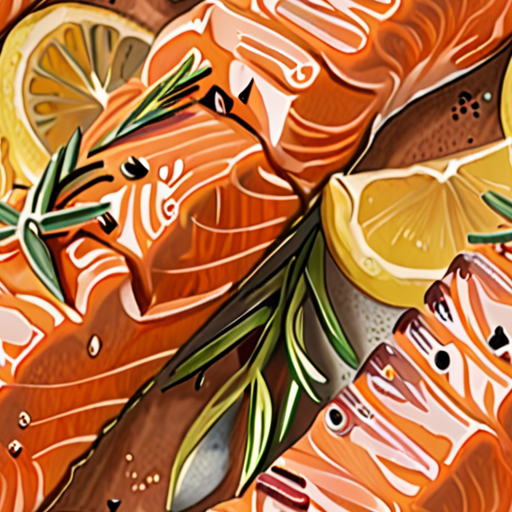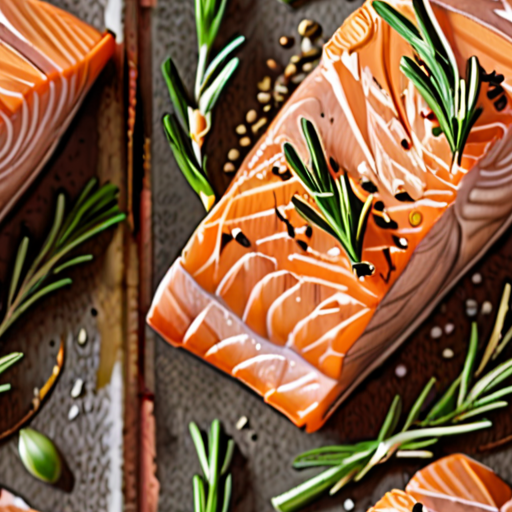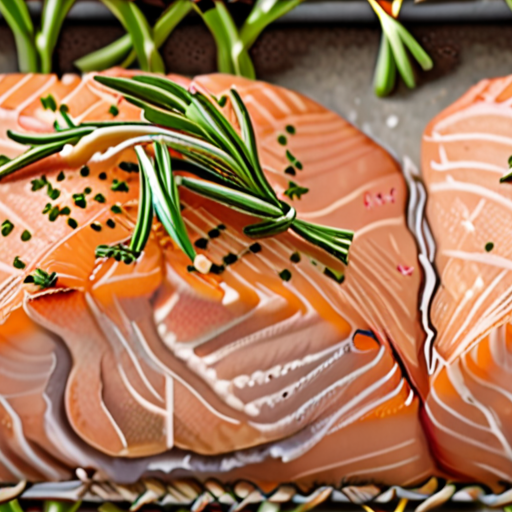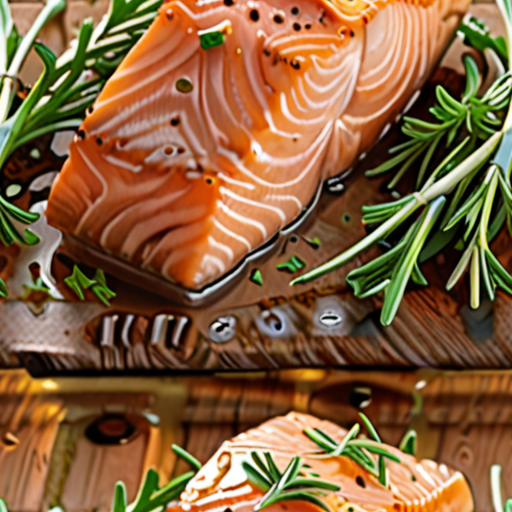When it comes to cooking salmon, one of the most popular methods is baking it with herbs, which not only adds flavor but also provides numerous health benefits. In this comprehensive guide, we’ll delve into the world of herb-baked salmon, exploring the best herbs to use, temperature settings, seasonings, and expert tips from renowned chefs like Gordon Ramsay and Martha Stewart. From classic combinations like herb-crusted salmon with lemon and garlic to unique pairings like pineapple salsa, we’ll cover it all. Whether you’re a seasoned chef or a beginner in the kitchen, our ultimate guide will provide you with the knowledge and inspiration needed to create mouth-watering, herb-baked salmon dishes that impress family and friends alike.

The Best Herb for Salmon
We’ve got the scoop on the perfect pairing for your next salmon dish.
- Dill: A classic combination that’s hard to beat, dill adds a bright, citrusy flavor that complements the rich taste of salmon perfectly.
- Lemon Balm: Similar to dill, lemon balm brings a light, refreshing flavor that pairs beautifully with the delicate taste of salmon.
- Tarragon: This slightly sweet and anise-flavored herb is a great match for salmon, adding depth and complexity to your dish.
- Parsley: While often overlooked, parsley can add a fresh, green flavor to your salmon that’s simply delightful.
When choosing the best herb for salmon, consider the type of dish you’re making and the flavors you want to emphasize. Dill and lemon balm work well in lighter, brighter preparations, while tarragon and parsley pair nicely with richer, more savory sauces.
At Only Fish Recipes , we love experimenting with different herbs and seasonings to find the perfect combinations for our favorite fish dishes. Whether you’re a seasoned chef or just starting out, we hope these suggestions inspire you to try something new and delicious!
Is it Better to Bake Salmon at 350 or 400?
Baking salmon can be a great way to prepare this healthy protein, and the temperature at which you cook it can affect the final result.
-
Temperature Considerations
The ideal baking temperature for salmon depends on several factors, including the thickness of the fillet and personal preference for doneness.
-
Lower Temperature (350°F)
Cooking salmon at 350°F can result in a more tender and moist texture, especially for thicker fillets.
-
Higher Temperature (400°F)
Baking salmon at 400°F can lead to a crisper exterior and a flakier interior, making it perfect for those who prefer a slightly charred finish.
-
-
Timing and Thickness
The cooking time will vary depending on the thickness of the salmon fillet and the temperature at which it’s baked.
-
Thicker Fillets (1-1.5 inches)
Cooking time at 350°F: 12-15 minutes per pound, while at 400°F: 8-10 minutes per pound.
-
Thinner Fillets (less than 1 inch)
Cooking time at 350°F: 6-8 minutes per pound, while at 400°F: 4-6 minutes per pound.
-
-
Internal Temperature
To ensure food safety, it’s essential to check the internal temperature of the salmon.
-
Safe Internal Temperature
The recommended internal temperature for cooked salmon is at least 145°F (63°C).
-
In conclusion, the choice between baking salmon at 350 or 400°F ultimately depends on personal preference and the desired texture.

What Seasoning Goes Best with Salmon?
When it comes to seasoning salmon, there are several options to consider, depending on your personal taste preferences and the type of dish you’re preparing.
- Cumin and Smoked Paprika: These two spices complement the rich flavor of salmon perfectly, adding a smoky depth that enhances its natural flavor.
- Oregano and Garlic Paste: Mixing oregano into garlic paste creates a savory blend that pairs well with the delicate flavor of salmon.
- Lime Zest and Coriander: Adding a squeeze of fresh lime juice and some grated lime zest can brighten up the flavor of salmon, while coriander adds a warm, earthy note.
For a more complex flavor profile, try combining these seasonings in different ways. For example, mix cumin and smoked paprika with oregano and garlic paste for a bold, savory flavor.
Remember, the key to seasoning salmon is to balance its natural flavor with complementary flavors that enhance its texture and aroma. Experiment with different combinations to find the perfect seasoning for your next salmon dish.
At Only Fish Recipes , we believe that the right seasoning can make all the difference in bringing out the full flavor of salmon. Whether you’re a seasoned chef or just starting to experiment with new recipes, our collection of fish-based dishes has something for everyone.
So why settle for bland, boring salmon when you can elevate it to new heights with the right seasoning? Try out these combinations and discover a whole new world of flavors!

How I Cook Salmon in the Oven
I’m excited to share my favorite method for cooking salmon in the oven, which yields a deliciously moist and flavorful dish every time.
- Step 1: Preheat the Oven
- Step 2: Prepare the Salmon
- Step 3: Season the Salmon
- Step 4: Create a Foil Parcel
- Step 5: Bake the Salmon
As a seasoned chef, I’ve experimented with various methods for cooking salmon, but I find that baking it in the oven produces the most consistent results. Here’s how I do it:
- Preheat your oven to 400°F (200°C). While the oven is heating up, prepare your salmon fillets by rinsing them under cold water and patting them dry with paper towels.
- Season the salmon with salt, pepper, and your choice of herbs and spices. I like to use a combination of lemon zest, garlic powder, and dried thyme for added flavor.
- Create a foil parcel by folding a large piece of aluminum foil into a square shape. Place the salmon fillet in the center of the foil, leaving a small border around it.
- Drizzle a tablespoon of olive oil over the salmon, then sprinkle a pinch of salt and pepper on top. Fold the edges of the foil tightly together over the salmon to seal, leaving some space in the parcel for steam to surround and cook the fish.
- Place the salmon parcel in a roasting tin and bake in the preheated oven for 12-15 minutes per pound, or until the salmon is cooked through and flakes easily with a fork.
And that’s it! By following these simple steps, you’ll be able to achieve perfectly cooked salmon every time. Whether you’re a seasoned chef or a beginner in the kitchen, this method is sure to impress.
Tips and Variations
Want to take your salmon game to the next level? Try adding some aromatics like lemons, onions, or bell peppers to the foil parcel for extra flavor. You can also experiment with different seasonings and marinades to give your salmon a unique twist.
Why I Love Cooking Salmon in the Oven
Cooking salmon in the oven is a game-changer for several reasons. Firstly, it’s incredibly easy – simply place the salmon in a foil parcel and let the oven do the work. Secondly, it’s a healthy option that allows you to control the amount of fat and calories in your dish. And finally, it’s a versatile method that can be adapted to suit any taste or dietary preference.
Should You Flip Salmon When Baking?
Baking salmon can be a delicate process, and one of the most common questions we get asked is whether or not to flip the fish during cooking.
- Why Flip Salmon?
- To prevent overcooking and promote even browning
- To ensure the fish cooks consistently throughout
- To prevent the formation of tough, rubbery texture
The Risks of Not Flipping Salmon
If you don’t flip your salmon, there’s a risk of:
- Overcooking
- The outside becoming too dark and burnt before the inside is fully cooked
- A tough, dry texture developing due to uneven heat distribution
The Benefits of Flipping Salmon
Flipping your salmon can result in:
- Even Cooking
- A tender, flaky texture throughout
- A beautifully browned exterior with a delicious crust
Tips for Flipping Salmon Like a Pro
To get the most out of flipping your salmon, try these tips:
- Use a Medium-High Heat
- Cook for 3-4 minutes per side, depending on thickness and personal preference
- Don’t overcrowd the pan – cook in batches if necessary
By following these simple steps and flipping your salmon regularly, you’ll be well on your way to achieving perfectly cooked, restaurant-quality fish every time!

How Does Martha Stewart Bake Salmon?
I’m excited to share my favorite method for baking salmon, inspired by the talented Martha Stewart.
- Step 1: Preheat the Oven
- Step 2: Prepare the Salmon
- Step 3: Add Aromatics
- Step 4: Assemble the Dish
- Step 5: Bake the Salmon
Preheat your oven to 400°F (200°C). This temperature ensures that the salmon cooks evenly and retains its moisture.
Rinse the salmon fillets under cold water, pat them dry with paper towels, and season both sides with salt and freshly ground black pepper.
In a small bowl, mix together minced garlic, chopped fresh herbs (such as parsley or dill), and a squeeze of lemon juice. Brush this mixture onto both sides of the salmon fillets.
Nestle the salmon fillets among a bed of fresh green vegetables (such as asparagus or Brussels sprouts) in a baking dish. Drizzle with olive oil and sprinkle with salt and pepper to taste.
Bake the salmon in the preheated oven for 12-15 minutes, or until it reaches an internal temperature of 145°F (63°C).
And that’s it! By following these simple steps, you’ll have perfectly cooked salmon every time, just like Martha Stewart.
Why This Method Works:
This method works because it allows the salmon to cook evenly and retain its moisture. The aromatics added in step 3 enhance the flavor of the salmon, while the green vegetables provide a delicious contrast in texture.
Conclusion:
Baking salmon is a great way to prepare this delicate fish, and by following Martha Stewart’s method, you can achieve perfect results every time. Whether you’re a seasoned chef or a beginner in the kitchen, this recipe is sure to become a staple in your household.

0 Comments